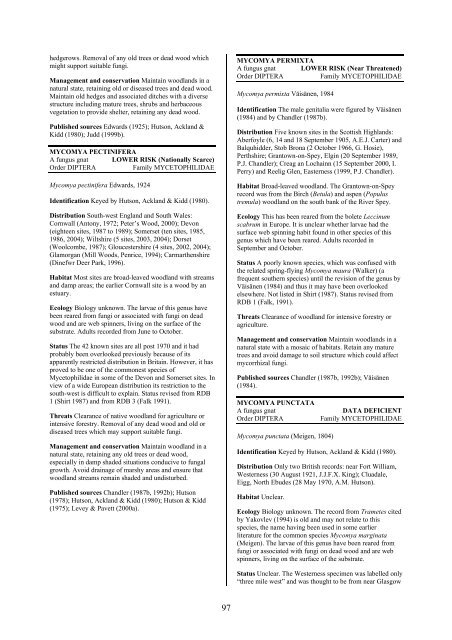Part 2: Nematocera and Aschiza not dealt with by Falk (1991) - JNCC
Part 2: Nematocera and Aschiza not dealt with by Falk (1991) - JNCC
Part 2: Nematocera and Aschiza not dealt with by Falk (1991) - JNCC
You also want an ePaper? Increase the reach of your titles
YUMPU automatically turns print PDFs into web optimized ePapers that Google loves.
hedgerows. Removal of any old trees or dead wood which<br />
might support suitable fungi.<br />
Management <strong>and</strong> conservation Maintain woodl<strong>and</strong>s in a<br />
natural state, retaining old or diseased trees <strong>and</strong> dead wood.<br />
Maintain old hedges <strong>and</strong> associated ditches <strong>with</strong> a diverse<br />
structure including mature trees, shrubs <strong>and</strong> herbaceous<br />
vegetation to provide shelter, retaining any dead wood.<br />
Published sources Edwards (1925); Hutson, Ackl<strong>and</strong> &<br />
Kidd (1980); Judd (1999b).<br />
MYCOMYA PECTINIFERA<br />
A fungus gnat LOWER RISK (Nationally Scarce)<br />
Order DIPTERA<br />
Family MYCETOPHILIDAE<br />
Mycomya pectinifera Edwards, 1924<br />
Identification Keyed <strong>by</strong> Hutson, Ackl<strong>and</strong> & Kidd (1980).<br />
Distribution South-west Engl<strong>and</strong> <strong>and</strong> South Wales:<br />
Cornwall (Antony, 1972; Peter’s Wood, 2000); Devon<br />
(eighteen sites, 1987 to 1989); Somerset (ten sites, 1985,<br />
1986, 2004); Wiltshire (5 sites, 2003, 2004); Dorset<br />
(Woolcombe, 1987); Gloucestershire (4 sites, 2002, 2004);<br />
Glamorgan (Mill Woods, Penrice, 1994); Carmarthenshire<br />
(Dinefwr Deer Park, 1996).<br />
Habitat Most sites are broad-leaved woodl<strong>and</strong> <strong>with</strong> streams<br />
<strong>and</strong> damp areas; the earlier Cornwall site is a wood <strong>by</strong> an<br />
estuary.<br />
Ecology Biology unknown. The larvae of this genus have<br />
been reared from fungi or associated <strong>with</strong> fungi on dead<br />
wood <strong>and</strong> are web spinners, living on the surface of the<br />
substrate. Adults recorded from June to October.<br />
Status The 42 known sites are all post 1970 <strong>and</strong> it had<br />
probably been overlooked previously because of its<br />
apparently restricted distribution in Britain. However, it has<br />
proved to be one of the commonest species of<br />
Mycetophilidae in some of the Devon <strong>and</strong> Somerset sites. In<br />
view of a wide European distribution its restriction to the<br />
south-west is difficult to explain. Status revised from RDB<br />
1 (Shirt 1987) <strong>and</strong> from RDB 3 (<strong>Falk</strong> <strong>1991</strong>).<br />
Threats Clearance of native woodl<strong>and</strong> for agriculture or<br />
intensive forestry. Removal of any dead wood <strong>and</strong> old or<br />
diseased trees which may support suitable fungi.<br />
Management <strong>and</strong> conservation Maintain woodl<strong>and</strong> in a<br />
natural state, retaining any old trees or dead wood,<br />
especially in damp shaded situations conducive to fungal<br />
growth. Avoid drainage of marshy areas <strong>and</strong> ensure that<br />
woodl<strong>and</strong> streams remain shaded <strong>and</strong> undisturbed.<br />
Published sources Ch<strong>and</strong>ler (1987b, 1992b); Hutson<br />
(1978); Hutson, Ackl<strong>and</strong> & Kidd (1980); Hutson & Kidd<br />
(1975); Levey & Pavett (2000a).<br />
MYCOMYA PERMIXTA<br />
A fungus gnat LOWER RISK (Near Threatened)<br />
Order DIPTERA<br />
Family MYCETOPHILIDAE<br />
Mycomya permixta Väisänen, 1984<br />
Identification The male genitalia were figured <strong>by</strong> Väisänen<br />
(1984) <strong>and</strong> <strong>by</strong> Ch<strong>and</strong>ler (1987b).<br />
Distribution Five known sites in the Scottish Highl<strong>and</strong>s:<br />
Aberfoyle (6, 14 <strong>and</strong> 18 September 1905, A.E.J. Carter) <strong>and</strong><br />
Balquhidder, Stob Brona (2 October 1966, G. Hosie),<br />
Perthshire; Grantown-on-Spey, Elgin (20 September 1989,<br />
P.J. Ch<strong>and</strong>ler); Creag an Lochainn (15 September 2000, I.<br />
Perry) <strong>and</strong> Reelig Glen, Easterness (1999, P.J. Ch<strong>and</strong>ler).<br />
Habitat Broad-leaved woodl<strong>and</strong>. The Grantown-on-Spey<br />
record was from the Birch (Betula) <strong>and</strong> aspen (Populus<br />
tremula) woodl<strong>and</strong> on the south bank of the River Spey.<br />
Ecology This has been reared from the bolete Leccinum<br />
scabrum in Europe. It is unclear whether larvae had the<br />
surface web spinning habit found in other species of this<br />
genus which have been reared. Adults recorded in<br />
September <strong>and</strong> October.<br />
Status A poorly known species, which was confused <strong>with</strong><br />
the related spring-flying Mycomya maura (Walker) (a<br />
frequent southern species) until the revision of the genus <strong>by</strong><br />
Väisänen (1984) <strong>and</strong> thus it may have been overlooked<br />
elsewhere. Not listed in Shirt (1987). Status revised from<br />
RDB 1 (<strong>Falk</strong>, <strong>1991</strong>).<br />
Threats Clearance of woodl<strong>and</strong> for intensive forestry or<br />
agriculture.<br />
Management <strong>and</strong> conservation Maintain woodl<strong>and</strong>s in a<br />
natural state <strong>with</strong> a mosaic of habitats. Retain any mature<br />
trees <strong>and</strong> avoid damage to soil structure which could affect<br />
mycorrhizal fungi.<br />
Published sources Ch<strong>and</strong>ler (1987b, 1992b); Väisänen<br />
(1984).<br />
MYCOMYA PUNCTATA<br />
A fungus gnat<br />
Order DIPTERA<br />
Mycomya punctata (Meigen, 1804)<br />
DATA DEFICIENT<br />
Family MYCETOPHILIDAE<br />
Identification Keyed <strong>by</strong> Hutson, Ackl<strong>and</strong> & Kidd (1980).<br />
Distribution Only two British records: near Fort William,<br />
Westerness (30 August 1921, J.J.F.X. King); Cluadale,<br />
Eigg, North Ebudes (28 May 1970, A.M. Hutson).<br />
Habitat Unclear.<br />
Ecology Biology unknown. The record from Trametes cited<br />
<strong>by</strong> Yakovlev (1994) is old <strong>and</strong> may <strong>not</strong> relate to this<br />
species, the name having been used in some earlier<br />
literature for the common species Mycomya marginata<br />
(Meigen). The larvae of this genus have been reared from<br />
fungi or associated <strong>with</strong> fungi on dead wood <strong>and</strong> are web<br />
spinners, living on the surface of the substrate.<br />
Status Unclear. The Westerness specimen was labelled only<br />
“three mile west” <strong>and</strong> was thought to be from near Glasgow<br />
97
















